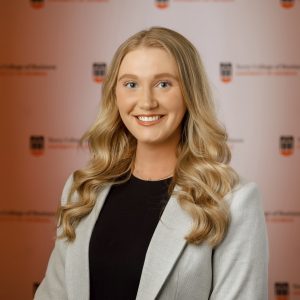
ISBM Research Newsletter - Volume 16, Issue 1 - May 2023
In This Issue . . .
We hope you are well and ready to enjoy the summer as the academic year draws to a close. Time to share the latest from the ISBM and look ahead at new initiatives for 2023-2024.
In the Feature of this Newsletter, our most recent Distinguished Research Fellow Srinath Gopalakrishna shares his insights on trade shows, their economic viability, importance for the B2B marketer, relevant metrics in an industry landscape dramatically altered by COVID-19, and new research directions. A must-read from the domain expert!
Our warmest congratulations to the three winners of the 2022 ISBM Doctoral Support Award Competition. Each winner received between $3,000 and $5,000 to advance their B2B marketing research. Please encourage your doctoral students, anywhere in the world, to submit an abstract by November 1, 2023, so they may join the ever-growing list of doctoral students (to date totaling 123) supported by the ISBM.
Please also bring the availability of the truly unique IPSS offering for the Fall of 2023 to the attention of your PhD students. We are excited that Gary Lilien, ISBM Founder, Research Director Emeritus, and Distinguished Research Professor of Management Science, has agreed to offer an IPSS seminar on “The B2B Knowledge Gap”. More details in this Newsletter.
Lynn Yanyo shares the latest from the membership. She reflects on a successful ISBM Members Meeting last Fall, the inaugural class of ISBM Practice Fellows, ISBM course offerings, and a new weekly newsletter for B2B Marketers. Lynn also looks forward to a September 2023 Members Meeting on AI in B2B.
Wrapping up, expect to hear from us soon again as we fine-tune our plans for 2023-2024, including a new trend study in the Fall and our biennial 2024 ISBM PhD Camp and Academic Conference where we will celebrate our 40th anniversary!
Wishing you a wonderful summer,
Stefan and Andrew
Stefan Wuyts
Director, ISBM
Email: suw282@psu.edu
J. Andrew Petersen
Associate Director, ISBM
Email: jap57@psu.edu
Reflections from ISBM Research Fellow Srinath Gopalakrishna
It is a great honor and privilege to be named a Fellow of the Institute for the Study of Business Markets as it showcases my deep engagement with B2B trade show research for the last 30 or so years. You have probably heard this before from senior management – “How did the event go? Was it a huge success for us?” Trade shows are big business (over $10 billion revenue in 2018) but in today’s world, data has become the Holy Grail. Companies are relentless in acquiring and processing information and answers based on personal observation and gut feelings (“. . . . our booth was packed with visitors all the time . . . .”) do not cut it anymore.
Trade shows involve three distinct stakeholders: attendees (prospective short- or long-term buyers and current customers), exhibitors (prospective short- or long-term sellers) and show organizers who coordinate with industry associations to organize and manage the event and facilitate buyer-seller interactions. There is consensus that trade shows provide opportunities to create value along three dimensions: (a) Educational (disseminate knowledge about new products, feature new research, highlight industry trends), (b) Networking (provide a setting for social interaction and help expand the professional network) and (c) Commercial (generate new business opportunities).
The Covid-19 pandemic altered the trade show industry landscape resulting in the emergence and rapid growth of virtual events. In this new reality where virtual and in-person events will coexist, three broad questions will dominate much of the discussion on how this important B2B communication medium is going to evolve in the years ahead.
Economic Viability of the Trade Show
The post-pandemic recovery of the trade show industry has begun to stabilize at a new normal where show organizers now face intense pressure to demonstrate value to other stakeholders in order to survive. Virtual events are here to stay as several attendees and exhibitors consider the cost advantages (travel costs, time away from office). Show organizers traditionally relying on three revenue streams (sale of floor space, sponsorships, and attendee registration fees) are now challenged to monetize virtual events and virtual engagement.
Hybrid versions of trade shows (some combination of online and in-person) can feature (a) the traditional in-person live event, (b) a real-time virtual experience occurring synchronously with the live show where virtual attendees pay a fraction of the full price, (c) an on-demand asynchronous experience where edited event content is made available to ‘visitors’ at a lower fee, or (d) promotion of event highlights via snippets and recaps that visitors and others share via social media. Show organizers may choose one or more of these versions.
Industry experts generally agree that the educational dimension of a trade show is executed quite satisfactorily (audience surveys affirm this fact too). Challenges remain, however, on the networking and commercial dimensions of the trade show as the value of a face-to-face encounter between exhibitors and attendees featuring a ‘happy hour’ or a product demo is very difficult to replicate in the online format.
Role of Trade Shows in the Marcom Mix
Exhibiting companies will have to address the virtual-only audience of prospective and current customers while trying to find a balance between participation in virtual versus in-person events. Overall cost-effectiveness of communication in B2B markets varies considerably across different channels (advertising, social media, trade show, sales calls, website) and across different stages of the customer buying process (Gopalakrishna, Lilien and Donsbach 2022). To ensure customer progression through the sales funnel, exhibiting companies must find the best approach to engage its audiences in multiple ways before, during and after the trade show. Synergies often exist between communication media – for example, trade shows are known to enhance the effectiveness of sales calls (Smith, Gopalakrishna and Smith 2004). Finding the right blend of marcom channels can offer a significant competitive edge for B2B marketers.
Trade Show Metrics and Measurement
The value derived from exhibiting at a trade show is a difficult task (see Gopalakrishna et. al. 1995 for an illustration) and its impact on the bottom line remains a debatable topic among managers. Typical metrics such as attraction, contact and conversion efficiency (Gopalakrishna and Lilien 1995) provide a basis to address trade show accountability. The online format has produced several digital metrics (# of online registrants, # of attendees, firmographics, event preferences, type of engagement) although many of these are in the early stages of development.
Tactical variables such as pre-show promotion, booth space and location, booth staff, attention-grabbing techniques and others that likely drive these performance metrics are of great interest to managers and academic researchers. Opportunities for quasi-experiments in the online and field settings to understand causal effects will add to our knowledge base in this area.
Opportunities for Research
There are several avenues for meaningful research that can bring great value to the academic and practitioner communities. I note a few examples below, but this is just the start of an exciting journey in an under-researched area in B2B marketing that has now entered uncharted territory. There is much to be explored and discovered to gain leverage from this important medium of communication that brings together a concentrated group of interested buyers and sellers.
- How do we effectively integrate online and in-person experiences to create a cohesive event?
- How do shifting corporate budgets for events and travel impact the in-person event format?
- How do we refine show effectiveness metrics in the digital format? What is their linkage to bottom-line outcomes?
- Which shows do we participate in-person versus online? What are the drivers of this decision?
- Which techniques are more effective in attracting our target audience in online events?
- How can attendee engagement be enhanced in the online setting?
- How do we assess online attendee satisfaction; how does that track with buying outcomes?

References
Gopalakrishna, Srinath, Gary L. Lilien and Andrew Donsbach (2022), Trade Shows in the Business Marketing Communications Mix, Handbook of Business-to-Business Marketing, Edward Elgar Publishing, 247-265.
Gopalakrishna, Srinath, Gary L. Lilien, Jerome D. Williams and Ian K. Sequeira (1995), “Do Trade Shows Pay Off?” Journal of Marketing, 59, 3 (July), 75-83.
Gopalakrishna, Srinath and Gary L. Lilien (1995), “A Three-Stage Model of Industrial Trade Show Performance”, Marketing Science, 14, 1 (Winter), 22-42.
Smith, Timothy M., Srinath Gopalakrishna and Paul M. Smith (2004), “The Complementary Effect of Trade Shows on Personal Selling”, International Journal of Research in Marketing, 21, 61-76.
Srinath Gopalakrishna
Professor of Marketing
University of Missouri
Email: srinath@missouri.edu
2022 Doctoral Support Award Competition Winners Announced
Winners have been named in the thirty-second annual Institute for the Study of Business Markets (ISBM) Doctoral Support Award Competition. Via the competition, the ISBM provides financial support for PhD dissertations for candidates in accredited doctoral programs.
This year there were three winners, named ISBM Doctoral Fellows. Each will receive a cash award to support their research. The winning proposals illustrate the breadth of the B2B marketing domain.
Award Winners
Outstanding Submission:
Molly Ahearne of the University of Georgia won the award for the outstanding submission with her dissertation proposal, Enhancing the Effectiveness of Sales Performance Rankings on Dashboards. Her Ph.D. Advisor is John Hulland.

Other Winners:
Amrita Mitra of Western University won with her dissertation proposal, Resilience in the Face of Adversity: Evidence from a Multinational Franchise System’s Expansion into Multiple Markets. Her Ph.D. Advisor is Kersi Antia.

Sakshi Babar of the University of Georgia won with her dissertation proposal, Do Climate Marketing Strategies Influence Firm Value in B2B Firms?. Her Ph.D. Advisor is Sundar Bharadwaj.

This year there were eleven entrants from which eight finalists were selected. Dissertation entries are judged on the rigor of the proposed work and the relevance of that work to business-to-business marketing practice. For more information about the competition, email the ISBM at ISBM@psu.edu or visit our website (https://isbm.org/doctoral-support-award-competition) for current information.
Headquartered in the Smeal College of Business at Penn State, the ISBM has been supporting business-to-business marketing research and practice since 1983. To date, ISBM has supported 123 doctoral students. Funding for this competition comes from the generous support of the ISBM Corporate Members.
IPSS Update: Current Fall 2023 and Upcoming Spring 2024 Offerings
Fall 2023: This fall IPSS will have Gary Lilien (Penn State University, ISBM) teaching a course titled, “The B2B Knowledge Gap”. Thank you, Gary, for agreeing to teach for IPSS. The course will start by focusing on identifying and understanding the gap in marketing research between Business-to-Business (B2B) and Business-to-Consumer (B2C) contexts. Next, Gary will examine current academic research by top B2B scholars across several topic areas guided by the Handbook of Business-to-Business Marketing (2nd Edition). Many of these top scholars will also join the sessions to discuss their chapters in the handbook as well as their current research and working papers. It will consist of approximately seven sessions of 120 minutes each beginning in late September of 2023.
Spring 2024: TBA. Please stay tuned for an announcement once we have lined up a professor to teach in Spring of 2024.
Please bring these PhD seminars to the attention of your promising B2B PhD students.
Students should follow the “Admission Procedure” and can register online. The deadline to register for the Fall 2023 course is Friday, September 8, 2023. We will announce the deadline for the Spring 2024 IPSS course once we have finalized the dates of the seminar.
For the complete course descriptions and overviews visit the course page.
We look forward to seeing you at these upcoming programs. Additionally, if you have any feedback or suggestions, please don’t hesitate to contact me.
J. Andrew Petersen
Associate Director
ISBM, Penn State
Email: jap57@psu.edu
Greetings from the ISBM Membership
With the pandemic declared “over” we are grateful for all of the members, fellows, practitioners and staff that stayed with us over these last 3 years.
Last fall, we held our first in-person meeting since 2019. We were hosted by member company Marmon Holdings, Inc. and had over 50 attendees in person and another 50 or so virtually.
The theme of the ISBM Members Meeting was Marketing’s Post-Pandemic Role in B2B Innovation: New Methodologies and Refilling the Top of the Funnel. You can find all of the presentations in B2B Pulse.
We also created our inaugural class of ISBM Practice Fellows. Similar, to our ISBM Distinguished Research Fellows, we honored 7 long-term practitioners of B2B Marketing for their contributions to education, research, and member support. Our first Practice Fellows include Dan Adams (AIM Institute), Ralph Cummins (EMM), Gerry Katz (AMS), Laura Patterson (Vision Edge), and Joanne Smith (Price2Profits). Additionally, we recognized past Executive Director and Smeal College professor Ralph Oliva with the title of Distinguished Practice Fellow.
Our next ISBM Members Meeting will be in-person on September 26-28, 2023, again in Chicago, hosted by member company Ingredion. This meeting will feature six presenters who will be sharing their latest insights on the changes Artificial Intelligence will drive in our B2B marketing spaces.
If you are on our mailing list, you are now seeing a weekly newsletter featuring additional content for direct application by our B2B Marketers. If you missed them, you can see the past articles here.
Our Webinar Series is also running. We have a 3-part webinar that is being presented by ISBM Distinguished Research Fellow Bernie Jaworski. “Part One: Setting the Direction: Mission, Vision and Purpose” is available on demand via B2BPulse. “Part Two: Culture and Values” will be live on July 11th at 12pm ET. You can register for our other webinars.
We continue to expand our educational offerings to practitioners and companies. We are currently running our third B2B Marketing Mastery TRACK, which provides a new B2B Marketer with all the basics of B2B Marketing over 4 months.
We look forward to seeing everyone in 2024 as we celebrate our 40th Anniversary of ISBM. Best wishes to everyone for continued good health.
Lynn
Lynn Yanyo
Executive Director, ISBM Corporate
Email: Lynn.Yanyo@isbmb2b.com


